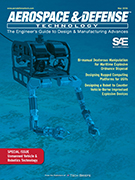Magazine

Aerospace & Defense Technology: February 2022
2022-02-01
What system Designers Should Know About MOSA Standards Microtube Technology A Catalyst for Next-Gen Aerospace Thermal Control Space Industry Test Challenges Advancing Metrology at Mach Speed Drone Mounted Inspection Breaks Barriers for F-35 RF Technology Helps Connect Avionics Systems Using Open-Cavity Plastic Packages in Avionics Applications Electronic Prognostics - A Case Study Using Global Positioning System (GPS) Prognostic health management (PHM) of electronic systems presents challenges traditionally viewed as either insurmountable or not worth the cost of pursuit, but recent changes in weapons platform acquisition and support requirements has spurred renewed interest in electronics PHM, revealing possible applications, accessible data sources, and previously unexplored predictive techniques.



















